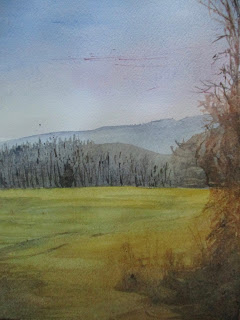 |
| (C) 2020 Dale DiMauro |
It is important to include red in the landscape. That may seem like an odd statement. However, when red is actually portrayed in the landscape I believe it should be exaggerated. It adds a lot of feeling to a picture. And it's something I do not do on a regular basis. Now I don't necessarily mean pure red but somewhere in the color spectrum of red.
Reds on my palette include burnt sienna, cadmium red and alizarin crimson. Burnt sienna is one of those earth colors that mixes well with others. I often add it to my landscapes, particularly in the fields as without it, something is missing. Also, it suggests a time of year or even a degree of humidity in the air.
Cadmium red I use when trying to achieve a pure red such as a stop sign color. It it frequently used with other pigments when I make light skin tones. Since it is opaque it can appear a bit chalky, but looks great in contrast to complementary greens. Also, a touch of red added to a blue sky mixture will give it a grayish tone which can be quite lovely.
Recently, I have come to embrace permanent alizarin crimson. Regular alizarin crimson I have read is fugitive meaning the pigment fades over time. So the permanent version I use a lot in making low horizon sky's often with cobalt blue. When those two colors are mixed on my palette the colors come to life.
The entanglement of growth on the right of this watercolor was primarily painted with burnt sienna.
No comments:
Post a Comment